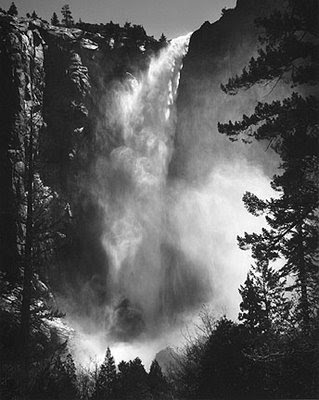martes, 12 de diciembre de 2017
Edward Steichen: «Nude Torso»
Edward Steichen (March 27, 1879–March 25, 1973) was an American photographer, painter, and art gallery and museum curator, born in Bivange, Luxembourg. His family moved to the United States in 1881 and he became a naturalized citizen in 1900.
Having established himself as a fine-art painter, in the beginning of the 20th century, Steichen assumed the pictorialist approach in photography and proved himself a master of it. In 1905, Steichen helped create the Little Galleries of the Photo-Secession with Alfred Stieglitz. After World War I, during which he commanded the photographic division of the American Expeditionary Forces, he reverted to straight photography, gradually moving into fashion photography. Steichen's photo of Greta Garbo (at right, featured on a Life cover) is recognized as one of the definitive portraits of the actress.
In World War II he served as Director of the Naval Photographic Institute. After the war, Steichen served until 1962 as the Director of Photography at New York's Museum of Modern Art.
Among other accomplishments, Steichen is appreciated for creating The Family of Man in 1955, a vast exhibition consisting of over 500 photos that depicted life, love and death in 68 countries. Steichen's brother-in-law, Carl Sandburg, wrote the introduction for the exhibition catalog (ISBN 0-8109-6169-5). As had been Steichen's wish, the exhibition was donated to the Grand-Duchy of Luxembourg. It is now permanently housed in the Luxembourg town of Clervaux
Etiquetas:
Edward Steichen
Ansel Adams: «Bridalveil Fall»
Bridalveil Fall,
Yosemite National Park, California, n.d.
Ansel Adams
(American, 1902-1984)
Ansel Adams’s documentation of the western landscape has taken on iconic significance as one of the defining purist visions of both the American West and of the photographic medium. Images such as this one, taken within the National Park System, have frequently been used to promote tourism and preservation of the landscapes they portray. El Capitan is a subject Adams photographed repeatedly, using the mountain’s towering presence to signify the sublime and unfathomable vastness of nature. Compositionally, Adams tends to frame these monuments of nature so that their iconic character is evoked, and to this aim, he avoids including the tourists and signs of habitation that surround the sites.
Born in San Francisco in 1902, Adams began working as an official photographer for the Sierra Club in 1928. In 1932 he and other California-based photographers, including Edward Weston, founded the group f64, which maintained an interest in the technically perfect photographic print. The name f64 is a reference to the smallest standardized aperture setting on the camera’s lens; photographs taken on this setting have the greatest depth of field meaning that nearly every object in the picture plane is in perfect focus. Adams developed a means of explaining exposure and development control known as the “zone system,” publishing his first book on how to master photographic technique in 1935. Over the next several years, Adams published a number of books and articles detailing his photographic approach; his titles include The Camera and the Lens (1948), The Negative (1948), The Print (1950), Natural Light Photography (1952), and Artificial Light Photography (1956). In the 1930s, Adams printed the photographs of Dorothea Lange, with whom he would collaborate with on several assignments including a study of the wartime shipyards in Richmond, California (1945), a report for Life on the Mormons in Utah, and a project on agriculture in the San Joaquin valley for Fortune (both published in the 1950s). His photographs of Yosemite Valley – a lifelong inspiration to Adams – and other subjects have been frequently reproduced, published as portfolios, and exhibited internationally. Adams was elected a Fellow of the American Academy of Arts and Sciences, and was critical in the founding of The Friends of Photography, the Ansel Adams Center for Photography, San Francisco, which existed from 1967 to 2001. In 2002, John Szarkowski organized a traveling exhibition of Adams’s work commemorating the 100th Anniversary of his birth. In 1985, a year after Adams’s death, an 11,760 foot mountain in Yosemite National Park was named Mt. Ansel Adams.
Etiquetas:
Ansel Adams,
Fotógrafo
Harry Callahan: «Eleanor and Barbara»
Etiquetas:
Harry Callahan
Harry Callahan: «Eleanor»
Etiquetas:
Harry Callahan
André Kertész: «A Bistro in the Quartier Latin»
Etiquetas:
Andre Kertész
sábado, 9 de diciembre de 2017
Ansel Adams / Gates of the Valley
viernes, 8 de diciembre de 2017
Tijuana, fundamental para carrera del fotógrafo Harry Crosby
Typical outdoor Tijuana burro portrait studio, 1964
Tijuana fue fundamental en la trayectoria de fotógrafo e historiador norteamericano Harry W. Crosby, autor de imágenes de Baja California que han logrado proyección internacional por su valor histórico.
«Fotografié muchos lugares de Tijuana, muchas y diferentes personas, fue una gran experiencia», expresó.
AQUÍ LA NOTA COMPLETA
Suscribirse a:
Comentarios (Atom)






